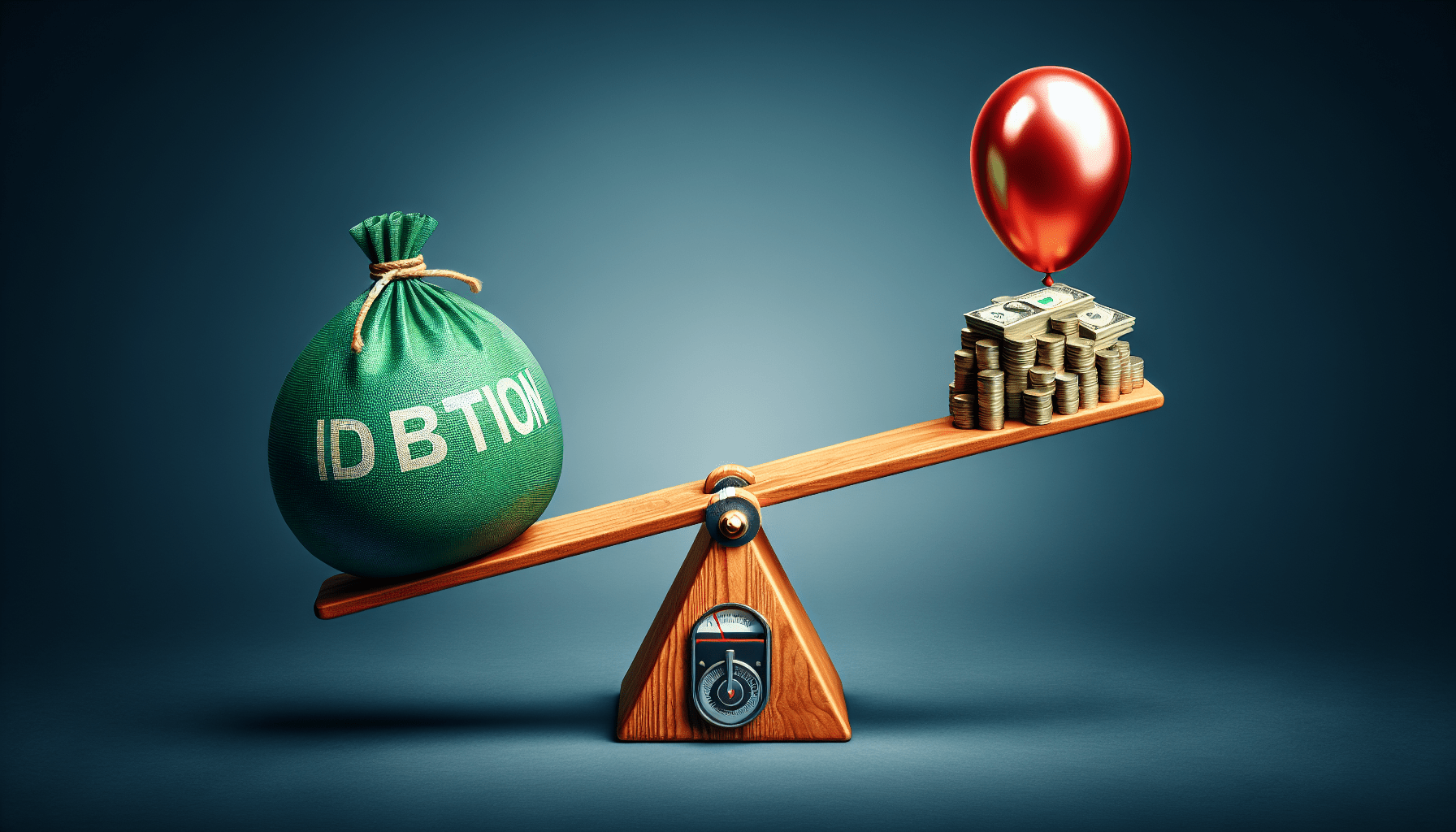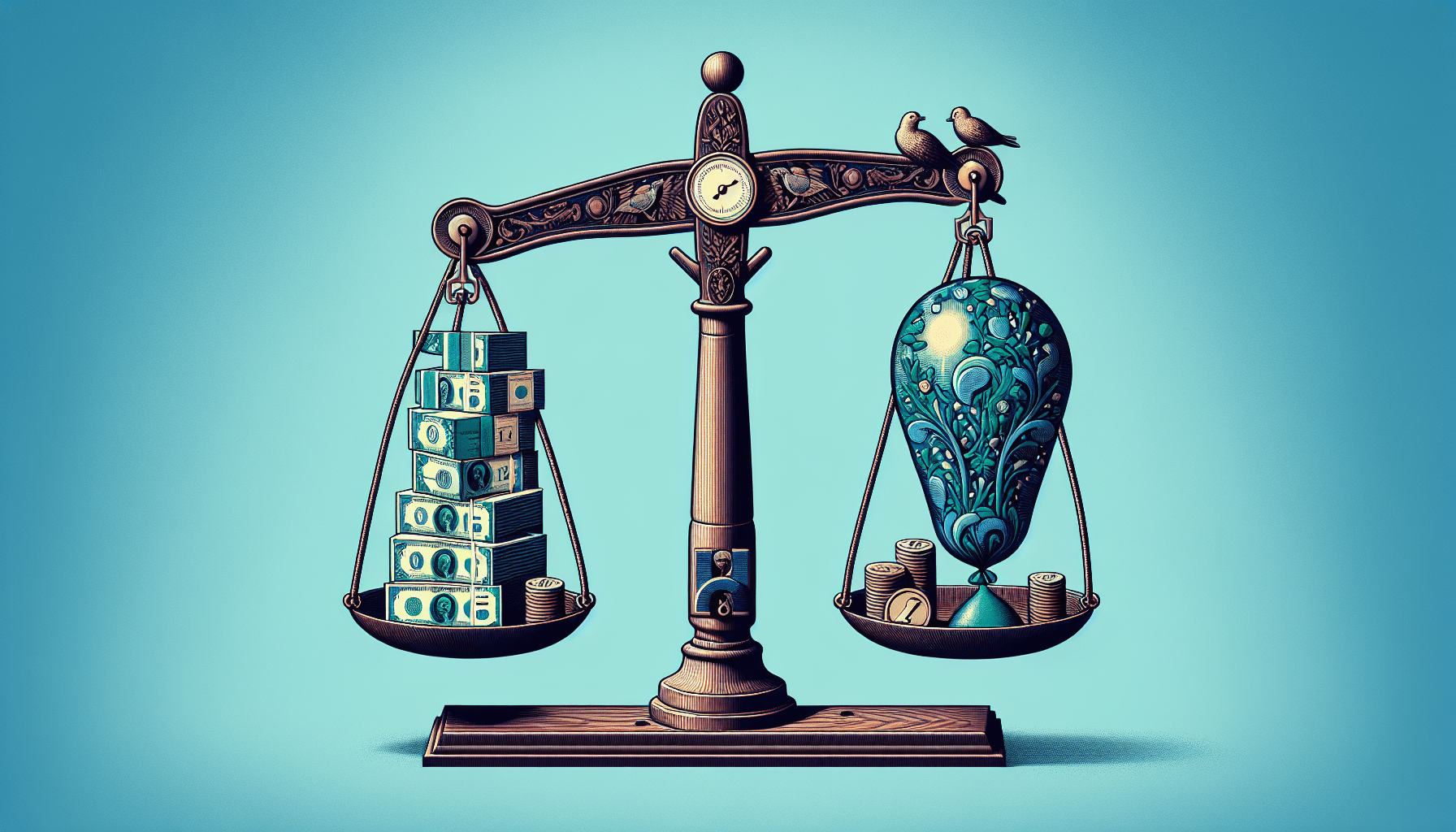Imagine for a moment that you are standing at the intersection of two of the most pressing economic issues of our time: the US national debt and inflation. Together, they form a complex web that impacts the lives of millions. But how are these two phenomena connected? In this intriguing article, we will explore the fascinating relationship between the US national debt and inflation, shedding light on their intricate dance and providing insights into the potential consequences for our economy. So, buckle up, because we’re about to embark on a journey into the heart of this economic puzzle!
Understanding the US National Debt
Definitions and interpretations of National Debt
The US National Debt refers to the total amount of money that the US government owes to its creditors, which includes individuals, corporations, and other countries. It is essentially the accumulation of the federal government’s annual budget deficits over time. The debt is measured in terms of Treasury securities, such as Treasury bonds, bills, and notes, that are sold by the government to finance its spending.
Interpreting the National Debt can be complex, as it is influenced by various economic factors and policies. Some view the debt as a necessary means for the government to finance public investments and stimulate economic growth. Others, however, express concerns about the long-term implications of high debt levels, including the burden it places on future generations and the potential for economic instability.
Main contributors to the US National Debt
Several key contributors have played a significant role in the accumulation of the US National Debt. One primary factor is government expenditures exceeding revenues, resulting in budget deficits. These deficits occur when spending on programs, such as defense, healthcare, and social security, surpasses the amount generated through tax revenues and other income sources.
Another contributing factor is the economic downturns or recessions that lead to decreased tax revenues and increased government spending on social welfare programs. Additionally, wars and military interventions can have a substantial impact on the debt, as they require significant financial resources to finance.
Identifying when and why the US debt has increased over time
The US National Debt has experienced significant increases over time, with several key periods standing out as major contributors to this growth. One notable time is during times of economic crisis, such as the Great Depression in the 1930s and the recent global financial crisis in 2008. These periods required increased government spending to stimulate the economy and prevent further deterioration.
Wars and military conflicts have also driven up the debt, as they necessitated substantial military expenditures. The costs associated with World War II, the Vietnam War, and more recently, the wars in Iraq and Afghanistan, resulted in significant debt increases.
Furthermore, structural factors, such as the growth of entitlement programs like Social Security and Medicare, have played a substantial role in increasing the national debt. The aging population and rising healthcare costs have put pressure on the government’s finances, contributing to the debt accumulation.
Understanding Inflation
Definition of Inflation
Inflation refers to the sustained increase in the general price level of goods and services in an economy over time. It indicates a decrease in the purchasing power of a currency, resulting in a higher cost of living. Inflation can occur due to various factors, such as changes in production costs, demand, or monetary policy.
Factors contributing to inflation
Multiple factors contribute to inflation. One significant factor is aggregate demand, which refers to the total demand for goods and services in an economy. When demand exceeds the available supply, prices tend to rise.
Changes in production costs, such as wages and raw material prices, also impact inflation. If companies face higher costs, they may pass those expenses on to consumers through higher prices.
Monetary factors, including the money supply and central bank policies, can also contribute to inflation. When the money supply increases rapidly or when central banks implement expansionary monetary policies, it can lead to excess liquidity in the economy, prompting higher inflation.
Impact of inflation on the economy and standard of living
Inflation can have both positive and negative effects on the economy and individuals’ standard of living. Moderate inflation can be conducive to economic growth, as it encourages spending and investment. It can also help reduce the real burden of debt, as borrowers repay loans with money that has decreased in value.
However, high inflation can lead to various negative consequences. It erodes the purchasing power of wages, reducing individuals’ ability to afford goods and services, which ultimately lowers their standard of living. Additionally, it can create economic uncertainty and hinder long-term planning for businesses and households. High inflation may also provoke speculative behaviors and distort investment decisions, leading to market inefficiency.
Theoretical Relationship Between National Debt and Inflation
How national debt could theoretically lead to inflation
Theoretically, an increase in the national debt can lead to inflation under certain conditions. When the government needs to finance its spending through borrowing, it issues Treasury securities. If the demand for these securities decreases, the government might be inclined to increase interest rates to attract investors. This action can influence other interest rates in the economy, such as those for mortgages and loans.
Higher interest rates can discourage consumer and corporate borrowing and spending, thus dampening economic activity. However, if the government continues to spend without matching revenue, it may resort to increasing the money supply through the central bank, leading to inflation. This occurs when the government monetizes its debt by effectively printing more money to finance its obligations.
Situations when higher national debt might not lead to inflation
Although the theoretical relationship suggests a potential link between national debt and inflation, it is important to note that higher debt does not always result in inflation. Several factors can mitigate the inflationary impact of debt.
Firstly, if the economy is experiencing low or stagnant demand, known as a demand-deficient economy, the increase in national debt might not cause significant inflation. In such situations, there is ample spare capacity in the economy, and increased government spending can boost demand without leading to excessive price increases.
Secondly, if the central bank effectively manages monetary policy to control inflation expectations and ensure price stability, the impact of debt on inflation can be minimized. By adjusting interest rates and employing other tools, central banks can fine-tune the money supply and promote price stability.
Key economic theories related to debt and inflation
Two key economic theories often discussed in relation to debt and inflation are the Quantity Theory of Money and the Modern Monetary Theory (MMT). The Quantity Theory of Money posits that inflation is primarily determined by changes in the money supply. If the money supply grows faster than the output of goods and services, inflation will occur.
On the other hand, MMT challenges the traditional perspective by arguing that governments with sovereign currencies, like the US, can essentially create money to finance their spending without fear of insolvency. According to MMT, inflation is a result of excessive aggregate demand, not necessarily government spending.
Historical correlation between US National Debt and Inflation
Analyzing past instances of high debt and inflation
Examining past instances of high debt and inflation in the US reveals a mixed picture. For example, during the post-World War II period, the US experienced a substantial increase in debt, largely driven by war spending. However, inflation remained relatively tame during this time, mainly due to effective monetary policy and strong economic growth.
In contrast, the 1970s witnessed a phenomenon known as stagflation, characterized by high inflation and stagnant economic growth. The combination of rising oil prices, expansionary fiscal policies, and loose monetary policy contributed to this challenging period.
More recently, following the 2008 financial crisis, the US government implemented significant stimulus measures, resulting in a significant increase in the national debt. However, inflation remained relatively low during this period due to a combination of weak aggregate demand and the Federal Reserve’s cautious monetary policy.
Case studies of times when debt did not lead to high inflation
There have been instances where high debt levels did not result in high inflation. Japan provides an interesting case study as its debt-to-GDP ratio is one of the highest globally, yet inflation has remained persistently low for decades. This is primarily due to factors such as an aging population, limited immigration, and deflationary pressures caused by economic stagnation.
Another example is found in some European countries, such as Germany, which have implemented austerity measures to reduce debt levels. Despite the reduction in debt, inflation has remained relatively low or even negative in these countries, mainly due to tight fiscal policies and other economic factors.
Understanding the role of central bank policies
The role of central bank policies is crucial in managing the relationship between national debt and inflation. Central banks have the tools and authority to influence interest rates, manage the money supply, and control inflation expectations. By implementing appropriate monetary policies, central banks can curb inflationary pressures resulting from high debt levels.
Additionally, central banks can impact the cost of borrowing for the government by purchasing or selling government bonds on the open market, which affects the yield on those securities. These actions influence the overall demand for government debt and can affect interest rates, thereby indirectly impacting inflation.

The Impact of Monetary Policies
Impact of Federal Reserve actions on inflation and national debt
The actions taken by the Federal Reserve, the central bank of the United States, play a significant role in managing inflation and its relationship with the national debt. Through its monetary policy tools, the Federal Reserve can influence interest rates and control the money supply, thereby impacting inflationary pressures.
During periods of economic weakness, the Federal Reserve often employs expansionary monetary policies, such as lowering interest rates and engaging in quantitative easing. These measures aim to stimulate borrowing, investment, and consumer spending, which can increase inflationary pressures.
Regarding the national debt, the Federal Reserve’s actions indirectly affect its impact on inflation. By purchasing large quantities of government securities, known as quantitative easing, the central bank effectively increases the demand for these bonds, which can keep interest rates lower. This mitigates the potential negative effects of high debt levels on inflation.
Importance of interest rates in managing inflation
Interest rates play a crucial role in managing inflation by influencing borrowing costs and affecting consumer and business spending decisions. When interest rates are low, borrowing becomes more affordable, resulting in increased spending and investment, which can lead to higher inflation.
Conversely, when interest rates are high, borrowing becomes more expensive, restraining consumer and corporate spending, and dampening inflationary pressures. Central banks adjust interest rates based on their inflation targets and their assessment of the overall economic conditions.
The Federal Reserve, for example, utilizes its Federal Funds Rate as a policy tool to influence short-term interest rates, thereby affecting borrowing costs for businesses and individuals. By raising or lowering this rate, the Federal Reserve aims to manage inflation expectations and promote price stability.
Correlation between monetary policy and economic stability
Monetary policy plays a critical role in maintaining economic stability, particularly in managing inflation and its potential effects on the national debt. Effective monetary policy aims to strike a balance between promoting economic growth and maintaining price stability.
If monetary policy is too expansionary, excessive inflation can erode the value of money, reduce purchasing power, and create economic uncertainty. On the other hand, if monetary policy is too contractionary, it can stifle economic growth and result in deflationary pressures, which can also have adverse consequences.
Therefore, central banks, such as the Federal Reserve, closely monitor economic indicators and adjust their monetary policies accordingly to maintain stability, ensure price stability, and minimize the potential adverse impact of high debt levels.
The Role of Fiscal Policies
Understanding how government spending impacts national debt and inflation
Government spending has a significant impact on both the national debt and inflation. When the government engages in deficit spending, whereby expenditures exceed revenues, it needs to finance the resulting budget deficits through borrowing. This accumulation of debt contributes to the national debt.
Increased government spending can have inflationary effects, primarily when the spending boosts aggregate demand and exceeds the available supply of goods and services. This excess demand can lead to price increases, as businesses raise prices to meet the increased demand.
Case studies of fiscal policies leading to inflation
Historically, several case studies highlight the potential inflationary consequences of certain fiscal policies. In the 1970s, expansionary fiscal policies, combined with loose monetary policies, contributed to high inflation in the United States. The significant increase in government spending, particularly on social programs and defense, contributed to this period of inflationary pressure.
Another case study is seen in countries that experienced hyperinflation, such as Zimbabwe and Venezuela. These nations implemented excessive government spending financed through money creation, leading to a rapid depreciation of their currencies and extreme levels of inflation.
Identifying triggers for government spending and its short and long-term effects
Triggers for government spending can vary depending on the economic and political circumstances. In response to recessions or periods of economic crisis, governments often increase spending to stimulate demand and aid in economic recovery. These spending measures can take the form of infrastructure projects, social welfare programs, or tax cuts.
While short-term effects may include increased economic activity and employment, long-term effects must be considered. High levels of government spending, particularly if not matched with sufficient revenue generation, can contribute to mounting debt burdens. This can create concerns about the sustainability of the debt and its potential impact on inflation and overall economic stability.

Effects of High National Debt on Inflation
Situations when high national debt leads to inflation
In certain situations, high national debt can lead to inflation. If the government resorts to monetizing its debt by effectively printing more money, the increased money supply can lead to inflationary pressures. This occurs when the demand for goods and services surpasses the available supply, causing prices to rise.
Additionally, if investors lose confidence in the government’s ability to manage its debt or if inflation expectations increase, they may demand higher interest rates for purchasing government bonds. This can further strain the government’s finances and lead to inflationary pressures.
Understanding the role of foreign debt
Foreign debt can influence the relationship between national debt and inflation. When a country relies heavily on foreign borrowing to finance its debt, it becomes vulnerable to changes in the global financial markets. Increased global interest rates or shifts in investor sentiment can lead to higher borrowing costs, potentially exacerbating inflationary pressures.
Furthermore, if a country’s foreign debt is denominated in a foreign currency, depreciation of the domestic currency relative to the foreign currency can increase the cost burden of servicing the debt. Inflation can arise from the need to generate more domestic currency to repay the debt denominated in foreign currency.
Analyzing cases of hyperinflation due to high national debt
Hyperinflation, a situation characterized by extremely rapid and typically accelerating increases in prices, has been observed in countries with high national debt levels. Zimbabwe in the late 2000s and more recently, Venezuela, exemplify the detrimental effects of excessive debt-financed government spending.
In these cases, governments relied on money creation to finance their spending, leading to a vicious cycle of increasing prices, collapsing currencies, and economic instability. Hyperinflation eroded the value of money, resulted in shortages of goods and services, and caused significant hardships for the population.
The Importance of Debt Management
Strategies for managing national debt
Effective debt management is crucial for maintaining fiscal sustainability. Governments employ various strategies to manage their national debt, including refinancing, debt consolidation, and debt restructuring. These approaches aim to ensure the government can meet debt obligations while minimizing the cost burden and risks associated with high debt levels.
Governments may also implement fiscal consolidation measures, such as tightening spending, increasing taxes, or promoting economic growth, to reduce debt accumulation over time. These strategies help stabilize debt levels and prevent excessive debt burdens.
Role of debt management in controlling inflation
Debt management can play a significant role in controlling inflation, particularly regarding the impact of fiscal policy. By maintaining fiscal discipline and ensuring that government spending aligns with revenue generation, debt levels can be kept in check. This, in turn, helps minimize the potential inflationary effects of high debt.
Furthermore, effective debt management can enhance investor confidence and contribute to stable interest rates. By providing a predictable repayment structure and managing debt maturity profiles, governments can reduce uncertainties surrounding the debt markets and prevent inflation expectations from increasing.
Consequences of poor debt management
Poor debt management can have severe consequences for an economy. High and unsustainable debt levels can trigger a loss of investor confidence, leading to higher borrowing costs and potential fiscal crises. Increased interest payments on the debt can divert resources away from critical investments in areas such as infrastructure, education, and healthcare.
Moreover, poor debt management can result in higher inflation and overall economic instability. When debt is mismanaged, the government’s ability to respond to economic shocks becomes limited, which can lead to a cycle of increasing debt burdens and worsened economic conditions.

The Role of Economic Cycle
Impact of recessions and booms on national debt and inflation
The economic cycle, with its alternating periods of recession and economic boom, influences the relationship between national debt and inflation. During recessions, when economic activity declines, tax revenues decrease, and government expenditures may need to increase to support the economy. This results in higher levels of government borrowing and an increase in the national debt.
During economic booms, however, increased economic activity and higher tax revenues can lead to surpluses, allowing the government to reduce the national debt or limit its growth. Additionally, strong economic growth can alleviate inflationary pressures, as increased productivity and consumer demand support price stability.
Analyzing the relationship between economic cycle and inflation
The economic cycle and inflation are interconnected. During periods of economic expansion, demand tends to increase, driving inflationary pressures. As wages rise, consumer spending increases, which can lead to higher prices for goods and services.
Conversely, during recessions, a decrease in demand can suppress inflationary pressures. Lower demand can result in diminished pricing power for businesses, leading to reduced price levels or even deflationary trends.
Changes in the economic cycle, therefore, influence the inflationary environment, which in turn impacts the national debt through its effect on government revenues and expenditures.
Causes and effects of cyclical deficits and surpluses
Cyclical deficits and surpluses refer to government budget balances that are influenced by the economic cycle. During times of economic expansion, revenues typically increase due to higher tax receipts, while spending on unemployment benefits and income support programs may decrease. This can lead to a budget surplus.
Conversely, during recessions, tax revenues decline, while spending on safety net programs and automatic stabilizers increase. This creates a budget deficit as government expenditures exceed revenues.
Cyclical deficits can contribute to an increase in the national debt, while surpluses help reduce debt levels. However, it is essential to manage these cyclical deficits and surpluses effectively, as prolonged deficits can lead to unsustainable debt burdens, while excessive surpluses can hinder economic growth and contribute to income inequality.
Effect of National Debt and Inflation on Everyday Life
Influence on wages and job market
The relationship between national debt and inflation can impact wages and the job market. High inflation erodes the purchasing power of wages, reducing real wages and diminishing individuals’ ability to afford goods and services. This can lead to a decline in living standards and a strain on household budgets.
Additionally, inflation can influence the job market. Higher inflation may compel companies to increase prices, and to offset rising costs, they may reduce labor expenses. This can result in slower wage growth and potentially increased unemployment.
Impact on the cost of living and savings
National debt and inflation can have a significant impact on the cost of living. Inflation erodes the value of money, leading to higher prices for essential goods and services. As inflation increases, individuals may find it more challenging to afford housing, groceries, healthcare, and other daily necessities.
Moreover, inflation can erode the value of savings. If the rate of inflation exceeds the interest earned on savings accounts or investments, it reduces the real value of savings over time.
Influence on financial markets and investments
National debt and inflation affect financial markets and investment decisions. High debt levels can create uncertainty in the financial markets and potentially increase borrowing costs for governments, businesses, and individuals. This can impact investment decisions, as higher borrowing costs can hamper business expansion plans and reduce profitability.
Inflation, on the other hand, can influence investment decisions through its impact on interest rates and the value of assets. Rising inflation can lead to higher interest rates, making borrowing more expensive. As a result, individuals and businesses may be less likely to undertake new investments, affecting economic growth.
Furthermore, inflation can impact the value of assets such as stocks, bonds, and real estate. Investors carefully consider inflationary expectations when making investment decisions, taking into account the potential impact on the returns and risks associated with different asset classes.
In conclusion, the relationship between the US National Debt and inflation is complex, influenced by various economic factors, policies, and historical experiences. While high debt levels can potentially lead to inflation under certain conditions, other factors, such as effective monetary and fiscal policies, can mitigate these inflationary pressures. Understanding and managing the impact of national debt and inflation is crucial for achieving sustainable economic growth, maintaining price stability, and ensuring the well-being of individuals and the overall economy.


